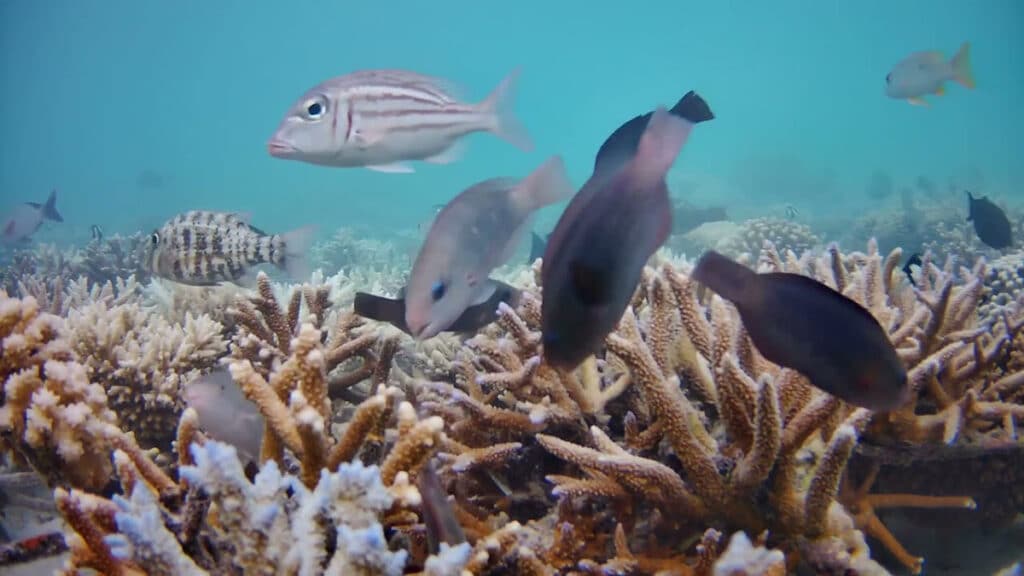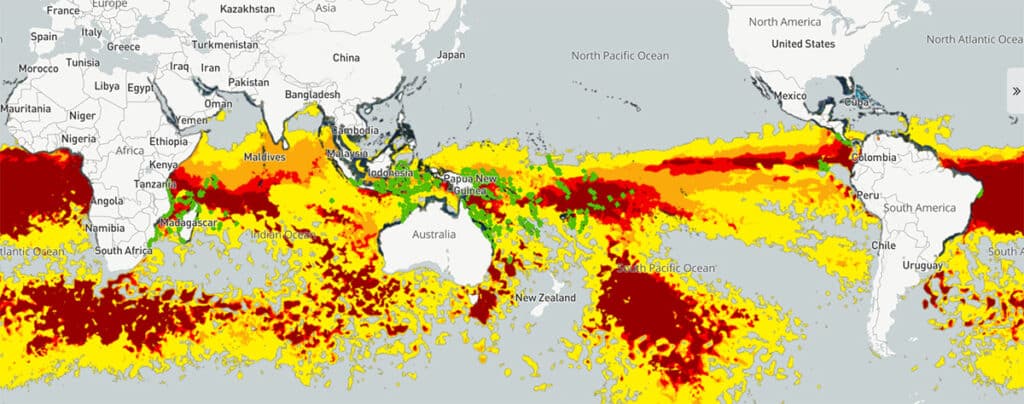Volcanoes are erupting in The Philippines, but on-fire Australia received some welcome rain. The Iran war cries have been called off and The Donald’s military powers are about to be hamstrung by the Senate. Meanwhile, his impeachment trial is starting, and we’re all on Twitter for a front-row seat.
What Could Go Right? Coral IVF
And other methods helping coral reefs bounce back
This is our weekly newsletter, What Could Go Right? Sign up here to receive it in your inbox every Thursday at 5am ET. You can read past issues here.
Coral IVF
You might have caught the news in early March that Australia’s Great Barrier Reef is undergoing another mass bleaching event, the fifth in eight years.
Coral bleaching does not mean that the coral is dead, but it renders the coral susceptible to disease and turns it white. It occurs when water temperatures get too hot and is of increasing concern to scientists due to climate change. Water temperatures are also especially hot this year due to El Niño, a recurring climate phenomenon.
Last week, the Great Barrier Reef’s Marine Park Authority announced that half of the more than 1,000 reefs surveyed there had experienced high or very high levels of coral bleaching. Less than 10 percent had extreme levels, and a quarter had none to low levels.
There is, however, some good news about coral, in the Great Barrier Reef and elsewhere.
In February, a paper from researchers at the University of Queensland in Australia found that coral reefs cover a larger area of the Earth’s waters than previously thought. Using high-resolution satellite images—for the first time at a global scale—and almost 500 data sets, they arrived at 348,361 square kilometers of shallow coral reef cover, versus previous estimates of roughly 150,000–300,000.
About a quarter is what we would normally think of as “coral reefs,” what researchers call hard coral habitat. The rest are different environments classed as parts of coral reefs, such as seagrass meadows.
Their map is the most comprehensive and detailed to date. It is also publicly available, a boon for countries unable to produce their own high-precision maps. The Pacific Ocean nation of Vanuatu, for instance, uses the Queensland team’s work to plan coral restoration after tropical cyclones.
Recent efforts have proven that reefs can bounce back from injury. Decades of dynamite fishing, which uses explosives to kill or stun masses of fish, had destroyed swathes of reefs in Indonesia, home to more coral than any other country. In 2018, teams from a Mars Inc.-funded nonprofit, in collaboration with local communities, began placing “reef stars”—hexagonal metal contraptions coated with coral sand—into the damaged reefs, to stimulate and aid regrowth.
Results published last month about the work were promising. Within four years, sections of the coral reef loaded with reef stars were growing at the same rate as undamaged ones. The reef-star sections had less species diversity, however.
The Mars nonprofit has sites around the world. There is even a daily livestream you can watch from one of their project locations in the Maldives, where reef stars were introduced in 2021.

While the reef stars method works best on physical damage, like from fishing and cyclones, what it can do for bleached coral is likely limited. There is a pilot project in the Great Barrier Reef, however, where reefs have been hit by both cyclones and bleaching. In addition to reef stars, the restoration plan involves releasing millions of coral larvae during the reef’s spawning period.
This process, dubbed “coral IVF,” is also used by the Great Barrier Reef Foundation in their restoration efforts, in addition to deploying heat-tolerant corals to reefs especially affected by bleaching.
Will these efforts amount to anything? Coral can bounce back after bleaching, even on their own. After the first recorded mass bleaching event in 1998, in the Belize Barrier Reef, hard coral cover—an indicator of general reef health—rebounded within a decade. In 2022, the Great Barrier Reef had the highest level of coral cover in more than 36 years, followed by similar levels in 2023.
According to a report from the Global Coral Reef Monitoring Network, global hard coral cover decreased to 29.52 percent in 2019, down from 32.5 percent in the late 90s, when data collection became more accurate and before the 1998 decline and subsequent recovery. So the trendline isn’t good, but it varies by region, and the shrink is less severe than you might guess from media coverage. It also might be worse or better by now—I couldn’t find up-to-date global data.
What worries scientists about reefs’ future is that in continually warming waters from climate change, the coral won’t have time to recover between bouts of bleaching. The species of coral that naturally repopulated the Great Barrier Reef to record levels in 2022, for instance, are heat-sensitive, which means progress could quickly flame out.
While deeper coral reefs may be insulated from climate change’s effects, not all species from more shallow reefs can survive there. Shallow reefs also protect coastlines, preserve fishing ecosystems and on-land agriculture, and generate tourist dollars.
This makes early alert systems for coral stress invaluable. One is Arizona State University’s Allen Coral Atlas, where scientists, conservationists, and policymakers can access the new high-precision map mentioned above. Researchers can also track coral bleaching using satellite imagery in combination with the United States government’s Coral Reef Watch, which has been measuring daily surface sea temperatures for the last decade.
In 2023, after extreme accumulations of coral bleaching heat stress in the eastern Pacific Ocean and Greater Caribbean, the National Oceanic and Atmospheric Administration (NOAA), which runs Coral Reef Watch, extended their watch, warning, and alert system by three levels. The highest of them, Alert Level 5, is risk of near-complete mortality, or 80 percent of corals.

You can see in the Allen Coral Atlas map above the world’s reefs marked in gray. Green represents where satellites have detected whitening. The yellow, orange, and red colors represent NOAA’s system, with the darkest red corresponding to Alert Level 2, risk of reef-wide bleaching with mortality of heat-sensitive corals.
Climate change may prove to be reefs’ undoing—or maybe we’ll reach a green future in which the reefs resurge. For now, amidst many threats, there are many hard at work to mitigate them. And to the surprise of scientists, we are even finding new reefs in waters thought hostile to coral’s existence.
Update: Last week I wrote about the national landscape of abortion two years post-Roe. Former President Donald Trump released a video on Monday stating that abortion should be left up to states; two days later, he told a reporter that he would not sign a national abortion ban. On Tuesday, Arizona’s Supreme Court upheld a near-total abortion ban on the books from 1864. Voters there will likely vote on the matter in November, in addition to eleven other states.
By the Numbers
12: The number of US states that now produce enough renewable energy to cover half of their electricity needs. The biggest producers? South Dakota, followed by Montana and Iowa.
2024: The year Slovakia will become coal-free, six years ahead of target.
40: The percent of Australia’s total electricity supply from renewables, up from 17 percent in 2017.
Quick Hits
🧠 The world’s most powerful MRI scanner, which can scan images at ten times the level of precision of traditional MRI machines, has been cleared by French regulators to begin scanning the brains of volunteers. The US and South Korea are also developing high-precision MRI scanners, but have not yet begun scanning patients with them.
🔥 In the news, wildfires are often symbolic of climate disaster. But do we actually know whether wildfires are increasing or decreasing over time? Our World in Data has a new page on wildfire data, and some of it may surprise you.
🇨🇦 Canada has announced that the government will pay for most contraceptive methods for women of reproductive age.
🧑⚖️ Massachusetts has pardoned all misdemeanor marijuana possession convictions, affecting potentially hundreds of thousands of people.
💷 The gender pay gap is the smallest ever recorded in Great Britain since data reporting became mandatory in 2017. Women, on average, are paid 91 pence for every one pound paid to men.
💪 The US Department of Labor’s March jobs report was even stronger than expected: “Strong job creation . . . coincided with an expanding labor force and moderate wage growth—pretty much an ideal situation for both workers and inflation-wary central bankers and investors,” reported Axios.
🧬 Biotechnology company LyGenesis has performed an experimental treatment to grow a “miniature liver” inside patients whose livers are failing. The mini liver would tide them over until a transplant surgery or make them healthy enough to receive one. And, epilepsy patients are reporting dramatic results from an experimental therapy that involves injecting stem cells into their brain.
🌲 In Romania, home to 65 percent of Europe’s virgin forests, an ambitious conservation project to create the “European Yellowstone” is in process.
👀 What we’re watching: Virginia lawmakers voted to raise the legal age of marriage to 18. If the governor signs the legislation into law, it would be the 12th US state with such a protection.
💡 Editor’s pick: Research from social psychologists has found that people’s self-critical thoughts after a conversation lead to a “liking gap” in which they underestimate how much their conversational partner liked them. The next time you interact with someone new, the researchers say, remember that people like you more than you think.
TPN Member Originals
(Who are our Members? Get to know them.)
- Four tips for identifying AI-generated media | Emma Explains | Emma Varvaloucas
- The truth about the Biden economy | Slow Boring | Matthew Yglesias
- Judges and prosecutors, targeted by Trump, will not be intimidated | Lucid | Ruth Ben-Ghiat
- The one big thing you can do for your kids | The Atlantic ($) | Arthur C. Brooks
- How to be a policy entrepreneur in the American ‘vetocracy’ | IFP | Alec Stapp
- What the ‘3 Body Problem‘ teaches about stagnation | Faster, Please! | James Pethokoukis
- ‘Little Women’ and the art of breaking grammatical rules | NYT ($) | John McWhorter
- How can the world make immigration work? Ask Canada | Bloomberg ($) | Tyler Cowen
- How the US media encourages Bibi’s dangerous brinksmanship | Nonzero | Robert Wright
 How the Israel-Gaza war could end—if Netanyahu wants it to | GZERO | Thomas L. Friedman & Ian Bremmer
How the Israel-Gaza war could end—if Netanyahu wants it to | GZERO | Thomas L. Friedman & Ian Bremmer- Six months of war in Gaza | Tangle | Isaac Saul


